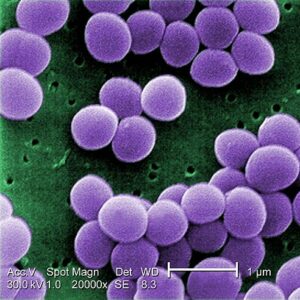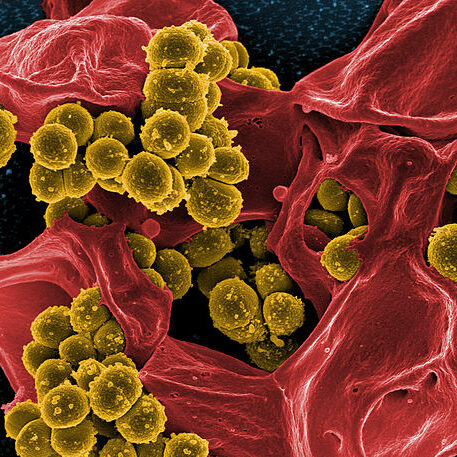About 30% of the human population is infected by this pathogenic bacterium. Some cause pneumonia, and skin disorders, while others cause food contamination.
Staphylococcus are ubiquitous bacteria that appear as irregular clusters of coccus cells. This article provides detailed facts about Staphylococcus and also about some Staphylococcus bacteria examples.
Some important Staphylococcus bacteria examples are mentioned below
- Staphylococcus aureus
- S. epidermidis
- S. saprophyticus
- S. lugdunensis
- S. haemolyticus
- S. caprae
- S. capitis
- S. xylosus
- S. vitulinus
- S. simulans
- S. simiae
- S. sciuri
- S. rostri
- S. arlettae
- S. auricularis
- S. borealis
- S. carnosus
- S. equorum
- S. gallinarum
- S. nepalensis
- S. pettenkoferi
- S. saccharolyticus
Staphylococcus aureus
Staphylococcus aureus is a versatile opportunistic pathogen. It is well equipped with a repertoire of different virulence factors such as enterotoxin-mediated virulence, antibacterial resistance, synthesize hemolysins, nuclease, and coagulases. These are capable to survive under a wide range of temperatures ranging from 7°C to 48°C and pH ranging from 4.2 to 9.3.
Since it is desiccation-tolerant, it can survive long stressful environments and start proliferating under optimal conditions. It releases enterotoxins resulting in food contamination. It can grow in 20% NaCl solution which makes it halotolerant and also in foods with high osmolyte concentration. This is due to intracellular osmoprotectants present in higher concentrations.

From Wikimedia
The types of ailments caused by S. aureus are as follows:
- Boils
- Carbuncle
- Mastitis
- Surgical wound disorder
- Scalded skin syndrome
- Sepsis
Some strains of S. aureus that exhibit resistance against methicillin are referred to as Methicillin-Resistant Staphylococcus aureus (MRSA). This resistance is active against beta-lactam antibiotics. Such conditions are more prevalent in hospitals and nursing homes. Initially, it was redistricted only to hospital-acquired illnesses, later it has become a community as well as livestock-acquired disorder.

From Wikimedia
Staphylococcus epidermis
Staphylococcus epidermis is another important symbiont staph bacteria. It is coagulase- negative, catalase-positive, facultative anaerobe that occurs frequently on human skin. However, it can become opportunistic bacteria once inside the human body. It enters human body mostly through medical devices or any prosthetic devices.
This bacteria can produce efficient biofilms which protect the bacterial cells from various antibiotics. The efficiency of biofilm depends upon the protein and exopolysaccharide compounds. S. epidermis can remain as commensal bacteria for many years since it doesn’t synthesize any aggressive toxins.

From Wikimedia
Staphylococcus saprophyticus
Staphylococcus saprophyticus is another coagulase-negative Gram positive bacteria. This bacteria doesn’t secrete hemolysin, thus it is non-hemolytic. It is recorded as the second most common bacteria responsible for UTI after E. coli.
S. saprophyticus can utilize nitrogen as it contain urease enzyme. This enzyme catabolize urea results in derivatives of ammonia. This mechanism enables the bacteria to colonize urinary tract. However the capability of utilizing urea is used to differentiate from other strains. This bacteria shows resistance against Novobiocin.
Staphylococcus lugdunensis
This coagulase-negative bacterium is responsible for skin and soft tissue inflammations. They mostly colonize skin and mucosal membranes and are more virulent as compared to other coagulase-negative species. The virulence property is due to the delta toxin- a toxin that acts as hemolytic peptide along with various enzymes such as DNase, lipase and capability to produce biofilms.
Staphylococcus haemolyticus
Similar to S. epidermis, this facultative anaerobic bacterium is also an inhabitant of human skin. This bacterium shows non-coagulase activity and can catabolize various substrates such as glucose, sucrose and trehalose. However, it can become opportunistic bacterium to immunocompromised patients as it shows various antibiotic-resistant strains. This bacterium is resistant to common antibiotic such as methicillin, erythromycin and gentamycin.
They can metabolize mannitol and thus can be distinguish from other Staphylococcus strains based on this property. Mannitol salt agar is used to select and differentiate among Staphylococcus strains. In this media, the concentration of NaCl (7.5%) acts as a selective parameter for the growth of bacteria. Strains that can assimilate mannitol releases acidic products which turn the phenol red into yellow. Thus appear as yellow-colored colonies.
Staphylococcus caprae
This is also a coagulase-negative staph bacterium that is originally isolated from goats. However, the other members of this species are of human origin. It synthesizes DNase, and biofilm and is found to colonize human skin and mucosal membrane. It is a commensal bacteria in goats and it is acquired as bone and joint inflammation in humans.
Staphylococcus capitis
This bacterium colonizes the human scalp, face, ear, and scrotum. This is not a harmful pathogen for common human being, however in immunocompromised patients, it can invade and causes serious
Staphylococcus xylosus
This is a coagulase-negative commensal bacterium that usually occur in salami fermentation. Since Staphylococcus genus is resistant to certain antibiotics, S. xylosus is resistant to novobiocin. However sensitive towards penicillin, erythromycin, tetracycline and methicillin. It can utilize various carbohydrate substrates such as lactose, maltose, D-(+) galactose and D-(+) mannose.
Staphylococcus vitulinus
This coagulase-negative bacteria is usually isolated from the meat of lamb, and chicken and also from animals such as horses, and whale. It has clustered cocci cells. This is often found in soybean fermentation.
Staphylococcus simulans
This species of Staphylococcus is rarely associated with human skin and UTI. It is also coagulase-negative and often remain in pairs or in clusters.
Staphylococcus simiae
This clustered cocci was first isolated from squirrel monkeys of South America and showed genetically related to S. aureus. This is an anaerobic, mesophilic, novobiocin-susceptible bacterium.
Staphylococcus sciuri
This is an important pathogenic bacteria that are responsible for inflammatory ailments, and also sepsis. It is a novobiocin-resistant and oxidase-positive bacterium usually prevalent in the hospital environment.
Staphylococcus rostri
This non-motile, catalase-positive, coagulase-negative bacterium was isolated from the noses of pigs display α-haemolysis on sheep blood agar. This strain can be differentiated from other Staphylococcus strains by absence of mannose fermentation, β-glucuronidase activity and presence of alkaline phosphatase activity.
Staphylococcus arlettae
This halotolerant, novobiocin-resistant bacterium is usually isolated from the skin of birds and mammals. It is present in clustered cocci. This bacteria can degrade azo dyes thus frequently isolated from effluents of textile industry.
Staphylococcus auricularis
This bacterium is an inhabitant of the human ear present either in pairs or in tetrads. It shows poor hemolytic activity.
Staphylococcus borealis
This facultative anaerobe is isolated from human blood culture from the University Hospital of North Norway. It is coccoid in morphology and usually forms clusters.
Staphylococcus carnosus
This bacterium is often used as a starter for sausage fermentation. This occurs in pairs or sometimes present singly. It contains GC content of about 36.4%. This bacterium has become a versatile microbiological tool in food fermentation.
Staphylococcus equorum
This clustered coccoid bacterium was isolated from the skin of horses and showed similarity genetically with S. xylosus. Some strains are also isolated from sausages while others are from Swiss mountain cheeses.
Staphylococcus gallinarum
This is isolated from human saliva and is closely related to S. epidermis. It is generally not pathogenic however it is often associated with patients suffering from Hepatitis B and eye contamination. These remain in pairs, clustered, or singly.
Staphylococcus nepalensis
This catalase-positive non-motile bacterium was isolated from respiratory tract of goats. The GC content is about 33%. It grows well in 10% NaCl
Staphylococcus pettenkoferi
This bacterium has been recently described in the year 2007. It is a spherical, non-motile, facultative anaerobic, coagulase negative commensal bacteria. It grows well in ambient environment.
Staphylococcus saccharolyticus
This bacterium is slow-growing usually found on human skin and shows 80% nucleotide similarity with S. capitis. Formerly it was known as Peptococcus saccharolyticus. It is responsible for endocarditis.
Frequently asked questions
What are the Staphylococcus bacteria?
Staphylococcus also includes pathogenic bacteria, are common colonizers of skin and mucosal membranes of human. The name Staphylococcus comes from Greek word “staphyle” which means grape and “kokkos” means berry.
Staphylococcus bacteria are also known as staph belongs to the family Staphylococcaceae. These are non-sporing, small, spherical, halotolerant, osmotolerant, facultatively chemoorganotrophic, non-motile, Gram-positive bacteria with 0.5-1 µm in diameter. They occur either singly or in irregular clusters. The cell wall of Staphylococcus consists of peptidoglycan along with murein, teichoic acid, and other surface anchored proteins.
Staphylococci can be divided into pathogenic and non-pathogenic strains based on the capability to synthesize the enzyme coagulase. Coagulase is an enzyme required for converting fibrinogen to fibrin that causes the plasma to clot. Staphylococcus aureus is the most important pathogenic bacterium capable of synthesizing coagulase and can be differentiated from other Staphylococci strains by growing on blood agar. Thus, frequently referred to as coagulase-positive.
Staphylococci can be further divided into slime producers and non-slime producers. The potential to synthesize slime is often considered a marker for pathogenic strains. Slime is a viscous, extracellular polysaccharide that allows bacteria to produce biofilm and also to adhere to smooth surfaces. It provides resistance against various antibiotics such as vancomycin and teicoplanin. The slime production is determined by using Congo red agar which differentiates between slime-forming and non-sliming forming strains.
Where are Staphylococcus bacteria found?
They are spread by either an asymptotic carrier or an infected person. Staphylococci can permeate almost every tissue of the body of an immune-compromised patient. Along with Streptococci, these bacteria manifest various pus-forming contamination such as boils, abscesses, and pneumonia.
Staphylococci are commensal bacteria that reside at various places in the human body starting from the upper respiratory tract, skin, and intestine. Some members of Staphylococci like S. epidermidis is typical skin resident while S. aureus usually inhabits the skin, oral cavity, nasal membrane, gastrointestinal tract, and urinary tracts. These bacteria can also grow on improperly cooked food, particularly ham, chicken, salad, and pastries.
Staph is responsible for food contamination. Due to heat resistance, it can escape the food processing methods and readily enter the food. They synthesize thermally stable enterotoxins which result in intoxication.
- Meiosis Stages Unveiled: A Deep Dive into Cellular Division
- Mitosis Stages: A Comprehensive Guide for Understanding Cell Division
- Meiosis: Unraveling the Intricacies of Cellular Division
- Mitosis Explained: A Comprehensive Guide to Cell Division
- Mitosis vs Meiosis: Unveiling the Mystery of Cell Division
- Calvin Cycle: Unraveling the Secrets of Plant Photosynthesis
Also Read:
- Do prokaryotes have enzymes
- Nucleic acid structure
- Aquatic ecosystem example 2
- Is fructose substrate
- Lysis in cell wall
- Krebs cycle in mitochondria
- Are protists heterotrophs
- Are bacteria extracellular
- Are decomposers biotic or abiotic
- Is osmosis diffusion

I am a doctoral student of CSIR- CIMAP, Lucknow. I am devoted to the field of plant metabolomics and environmental science. I have completed my post-graduation from the University of Calcutta with expertise in Molecular Plant Biology and Nanotechnology. I am an ardent reader and incessantly developing concepts in every niche of biological sciences. I have published research articles in peer-reviewed journals of Elsevier and Springer. Apart from academic interests, I am also passionate about creative things such as photography and learning new languages.
Let’s connect over Linkedin